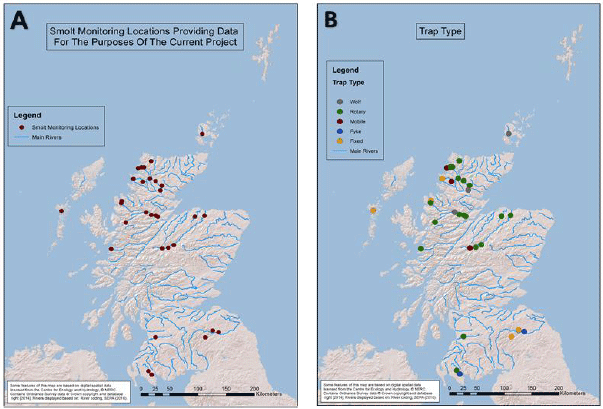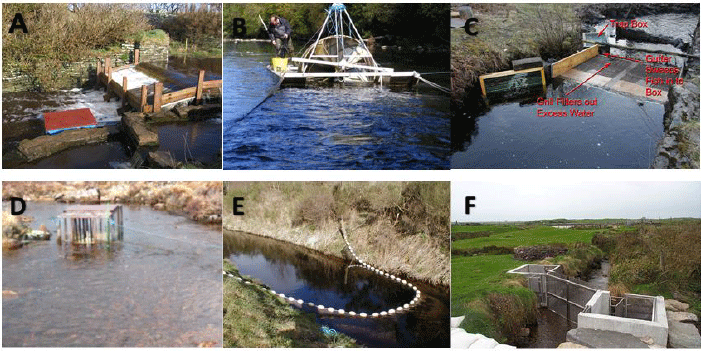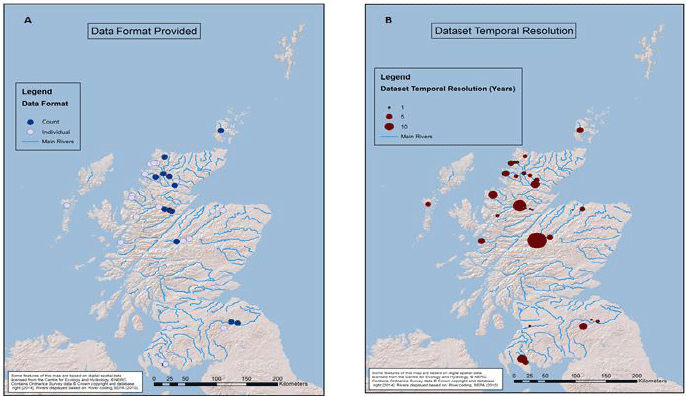Scottish Marine and Freshwater Science Volume 5 Number 6: Collation of Available Datasets on Smolt Populations in Scotland to Assess Migration Run Times
This project was undertaken in the context of the National Research and Monitoring Strategy for Diadromous Fish (NRMSD) to investigate the potential for interactions between diadromous fish and wind, wave and tidal renewable energy developments.
3. Results
3.1 Items Provided
Further to this report, a Microsoft Excel Document containing an extensive metadata summary and raw data for all sites and years available has been supplied to MSS. Full details of the spread sheet components and mapping data are provided in section 3.3. Thirdly, Geographical Information System ( GIS) computer mapping data has been provided as an ESRI ArcMap Document.
3.2 Spatial Coverage and Trap Type
The SFCC has collated data from a total of 31 locations in Scotland where smolt monitoring has been, or is currently being undertaken. Of these 31 locations, 14 are operated on second order tributary rivers and 17 are operated on first order main-stems. There are additional installations managed by MSS on the rivers Girnock and Baddoch (not part of the scope of this project) and 3 further smolt monitoring locations where identified that were not included in the data collation aspect of this project as detailed in Table 2.
Table 2. Additional smolt monitoring locations identified.
| Site | Organisation | Reason data was not requested |
|---|---|---|
| River Don | River Don Trust/ Glasgow University* | Sampling in 2013 was severely affected by extreme weather conditions rendering the data unsuitable for further analysis. |
| River Endrick | Loch Lomond Fisheries Trust* | Due to recent resourcing pressures the data was not able to be collated within the project timescales. |
| River Moffat | The River Annan Trust* | Data collected opportunistically from a fish farm intake was deemed not to be of sufficient resolution for the purposes of this project. |
* All organisations were supportive of the project and willing to contribute raw data.
The majority of smolt monitoring is carried out using rotary screw traps. In several long-term datasets alternative strategies are utilised. In addition to rotary screw traps, wolf, fixed, mobile and fyke strategies are used ( Fig. 1). Clarification on the nomenclature used is provided in Fig. 2 A-F, and additional photographs are also provided in appendix B.
Confirmation that smolt trap monitoring does not currently take place was received in writing or by telephone communication from the following organisations:
- River Ythan Fisheries Trust
- Deveron, Bogie and Isla Fisheries Trust
- Tay District Salmon Fisheries Board
- Forth Fisheries Trust
- Nith Catchment Fisheries Trust
- Clyde River Foundation
- Argyll Fisheries Trust
- Skye Fisheries Trust
- Brora Fisheries
- Helmsdale District Salmon Fishery Board
- Caithness District Salmon Fishery Board
- Northern Board
- Ness & Beauly Fisheries Trust
A number of organisations informed the SFCC of future smolt monitoring efforts due to begin in 2014 (Table 3). Additional information on future aspirations is detailed in individual questionnaire responses provided in full in Appendix B.
Table 3. Organisations commencing smolt monitoring in Spring 2014.
| Organisation | River | Years Planned |
|---|---|---|
| Argyll Fisheries Trust | Kinglass | 2014 onwards |
| Ness & Beauly Fisheries Trust | 2 locations t.b.c | 2014 onwards |
| Deveron, Bogie & Isla Fisheries Trust | Blackwater | 2014-2018 |
| Spey Foundation | Avon | 2014 onwards |
| Spey Foundation (Deveron managed) | Fiddich | 2014-2018 |
| Esk Rivers & Fisheries Trust | Rottal (South Esk) | 2014 onwards |
It should be noted that Shetland is the only outstanding region where the SFCC were unable to confirm the existence or otherwise of smolt monitoring efforts. To the best of the SFCC's knowledge we believe that this report provides a complete coverage of Scotland.
Figure 1. A: Smolt monitoring locations providing data for the purposes of the current project. Note: this is not an absolute map of locations as locations were identified that in eventuality were not part of the data provision aspect of this project. B: Map showing trap type including wolf, rotary [screw] mobile, fyke [net] and fixed methods. Nomenclature clarification and associated photographs are provided in Fig. 2.
Figure 2. Smolt Trap Images
A: Wolf trap operated by Malcolm Thomson/Heriot Watt University on the Eyrland Burn in Orkney.
B: Rotary screw trap operated by Ayrshire Rivers Trust on the River Ayr. Photo credit: Gillian McIntyre.
C: Fixed trap operated on the Tournaig River by Wester Ross Fisheries Trust. Photo credit: Ben Rushbrook/Peter Cunningham.
D: Mobile smolt trap operated by West Sutherland Fisheries Trust at Badna Bay. Photo credit: Shona Marshall.
E: Fyke net operated on the river Bladnoch by Galloway Fisheries Trust. Photo credit: Jackie Graham.
F: Fixed trap operated near Loch Nan Struban, North Uist: Photo credit: Outer Hebrides Fisheries Trust.
The meta-data summary spread sheet provides a detailed account of each dataset. Raw data is supplied within 4 standard formats with the majority being supplied as count level or individual fish length measurement (1mm) ( Fig.3). 2 further datasets were provided in the 5mm and 10mm fish length measurement format. Fish weights were recorded for a sub-set of the total sample in a limited number of locations.
Raw data is provided in a Microsoft Excel spread sheet containing 6 sheets labelled A-F:
A: Meta-data Summary.
B: Fishing Dates
C: Individual Fish Length (1mm)
D: Fish Count Level Data
E: Fish Length (5mm Counts)
F: Fish Length (10mm Counts)
The following Tables 4-9 provide information and attribute descriptions for the 6 works sheets contained in the excel spreadsheet.
Table 4. Explanation of columns A-W provided in spread sheet A: Meta-data Summary
| Worksheet Column | Column Title | Attribute Description |
|---|---|---|
| A | ID | Column number. Numbers 1-31 refer to datasets provided for this project |
| B | Smolt Monitoring Present | Refers to whether or not the organisation collected smolt trapping data. (Yes/No) |
| C | Organisation | Fisheries Trust or organisation name contacted for information on smolt monitoring. |
| D | Site | Location of smolt trap on the river. |
| E | River Order | The classification of the river water body the trap is situated in either 1 indicating river main-stem or 2 indicating tributary river. |
| F | X co-ordinate | Trap location given as a 6 figure X British National Grid Co-ordinate |
| G | Y co-ordinate | Trap location given as a 6 figure Y British National Grid Co-ordinate |
| H | No. years data available | Total number of years in which data has been provided. |
| I | Start Year | Information on the First year for which data has been provided |
| J | End Year | Information on the Final year in which data has been provided. 'On-going' indicates traps that will continue in 2014. |
| K | Years Data Available | A list of years ( YYYY) and year ranges ( YYYY- YYYY) for which data has been provided. |
| L | Trap Type | Type of trap employed to capture smolts at site; Rotary screw trap/ fyke net / fixed trap / wolf trap/ mobile fish trap |
| M | Strategy | Information on the smolt trap capture strategy either indicating Partial or Total river trap coverage of the river. |
| N | Data format supplied | Information on the data supplied as either Count ( C )/ Individual length 1mm (I)/ Individual length 5mm categories ( IF)/ Individual 10mm categories ( IT) |
| O | Lengths a subset of data | Are fish individual a subset of total data provided. Yes/No/ NA ( NA applies to datasets only provided as count level data). |
| P | Sampling Frequency | Information provides the seasonal sampling frequency for example daily or weekly. |
| Q | Species recorded | A list of species recorded as capture in the trap. |
| R | Weights recorded | Information on the collected fish weights from the capture fish given as Yes or No |
| S | Method for assessing capture efficiency | A description of the capture efficiency and related calibration techniques. |
| T | Additional Environmental Data | A description of any additional environmental variables collected. |
| U | Stocking | Information is provided on whether the river is stocked or not. Yes/No |
| V | Life Stage At Stocking | If it is identified that the river is stocked the stage at which stocking occurs is recorded here including Egg / alevin / un-fed fry / fry / parr / pre-smolt / smolt |
| W | Dataset Notes | General notes on the dataset and issues if identified |
Table 5. Explanation of columns A-F provided in spread sheet B: Fishing Dates
| Worksheet Column | Column Title | Attribute Description |
|---|---|---|
| A | Site | Location of smolt trap (river) |
| B | Year | YYYY Year in which the data was collected. |
| C | Start Date | First day each year when trap is in operation ( DD/ MM/ YYYY) |
| D | End Date | Last day each year where trap is in operation ( DD/ MM/ YYYY) |
| E | Dates within the season during which trap was not in operation | Information is recorded on non-operational periods of the trap within trapping season for example; 17/04/2003, 21/04/2003-24/04/2003. |
| F | Comments on reasons why trap was not in operation | Information is provided on the reasons for non-operational traps during smolt trapping season for example; high flows, malfunction. |
Table 6. Explanation of columns A-L provided in spread sheet C, Individual fish length (1mm)
| Worksheet Column | Column Title | Attribute Description |
|---|---|---|
| A | Site | Location of smolt trap (river) |
| B | Date | Date ( DD/ MM/ YYYY) of fish capture |
| C | Species | Species of fish captured in smolt trap including Salmon (S), Sea Trout ( ST), Trout (T), Hybrid (H). |
| D | Length | Measured Fish fork length (mm) |
| E | Weight | Weight of fish in Grams (g) |
| F | Capture Status | Captured (C), Captured and marked (M), Marked recapture (R) |
| G | Tag No. | Tag number or code if available of this specific fish. |
| H | Tag Type | Type of tag employed if marking the fish e.g. Passive Interference Transponder ( PIT), elastomer |
| I | Water Temperature | Local river water temperature (◦C) recorded on the day of collecting data from the trap. |
| J | River level | River flow height standardised to mm recorded on the day of collecting data from the trap. |
| K | Other Species Captured | Other fish species that have been captured in a smolt trap are recorded here for example, pike, eel, lamprey, stickleback |
| L | Comments | Any additional comments on this individual fish observation |
Table 7. Explanation of columns A-K provided in spread sheet D: Fish Count Level Data
| Worksheet Column | Column Title | Attribute Description |
|---|---|---|
| A | Site | Location of smolt trap (river) |
| B | Date | ( DD/ MM/ YYYY): Date of count entry for each species captured. |
| C | Trap in Operation | (Yes/No) Yes indicated if trap is effectively fishing. |
| D | Species | Species of fish captured in smolt trap including Species (Salmon (S), Sea Trout ( ST), Trout (T)) |
| E | No. Fish Captured (not marked) | Number of fish captures that were not marked or tagged in any way. (If no tagging was undertaken by respective organisation all fish captures are entered in this column only). |
| F | No. Captured and marked | Number of fish captured and marked |
| G | No. Marked Recaptures | Number of fish that were captured and found to be previously marked. |
| H | Water temp | Local river water temperature (◦C) recorded on the day of collecting data from the trap. |
| I | Flow | River flow height standardised to mm recorded on the day of collecting data from the trap. |
| J | Comments | Any additional comment on that respective fish count |
| K | Other Species Captured | In the smolt trap e.g. count of trout, eel, stickleback, lamprey |
Table 8. Explanation of columns A-W provided in spread sheet E: Fish Length
(5mm Counts)
| Worksheet Column | Column Title | Attribute Description |
|---|---|---|
| A | Site | Location of smolt trap (river) |
| B | Length (mm) | 5mm category counts supplied in intervals between 50mm and 200mm for each year. |
| C -E | 2006 | Separate counts of 'unsmolted', 'part' and 'smolted' salmon. |
| F -H | 2007 | Separate counts of 'unsmolted', 'part' and 'smolted' salmon. |
| I -K | 2008 | Separate counts of 'unsmolted', 'part' and 'smolted' salmon. |
| L - N | 2009 | Separate counts of 'unsmolted', 'part' and 'smolted' salmon. |
| O -Q | 2010 | Separate counts of 'unsmolted', 'part' and 'smolted' salmon. |
| R -T | 2011 | Separate counts of 'unsmolted', 'part' and 'smolted' salmon. |
| U -W | 2012 | Separate counts of 'unsmolted', 'part' and 'smolted' salmon. |
Table 9. Explanation of columns A-D provided in spread sheet F: Fish Length
(10mm Counts)
| Worksheet Column | Column Title | Attribute Description |
|---|---|---|
| A | Site | River Location of smolt trap (river) |
| B | Length | 10mm category counts between 100mm and 310mm for the single season supplied. |
| C | Trout | Count of trout captured in the smolt trap. |
| D | Salmon | Count of salmon captured in the smolt trap. |
3.4 Dataset Observations
Questionnaire responses indicate that data from the 31 locations was collected predominantly for a range of locally driven research questions and purposes noted in Appendix B. In collating this data into a standard format a number of outstanding considerations have arisen. Firstly, methodology applied to record the aspect of; when fishing did not occur, fishing did occur without the trap being checked, and fishing did occur with the trap being checked resulting in a catch of 0 is not consistent across the dataset between all sites. Likewise, the specific manner in which an organisation records the beginning and end of their trapping season varies across the network. Thirdly, data on other fish species (including trout) was provided to the SFCC in a range of formats. This information has been aggregated into the 'other species' column where it was provided. It should also be noted that in certain cases, other fish species are entered as individual fish observations with blanks in the 'length' and 'species' column. In this case rather than remove these entries the SFCC has chosen to include them to ensure that all raw data is preserved. For a brief explanation of notes and considerations relevant to each dataset please see column W in spread sheet A.
Temporal coverage of data is variable (Fig. 3). Of particular note, annual coverage and dataset duration at multiple locations is further constrained when only individual fish measurement datasets are considered. While the first trap began recording in 1973 at the Spey Dam, 1994 provides the next year in which a further location commenced operation on the river Bran, a tributary of the Conon. Recent years from 2006 onwards provide the greatest number of sites sampled in any one year for both count level and individual fish length level datasets (Tables 6 and 7).
Figure 3. A: Map showing monitoring locations of fish count level (count) and individual fish length (individual) datasets. Please note that a number of these individual datasets represent a subset of fish sampled from the total count observed. B: Map showing total number of years in which data was provided from smolt monitoring locations for the current project as proportional symbols. The largest circle represents a 37 year count dataset provided by Spey Foundation.
Table 10. Temporal distribution of smolt monitoring data (all formats) as provided for this project. In some cases further years exist but it was not possible to provide the data within the project timescales.
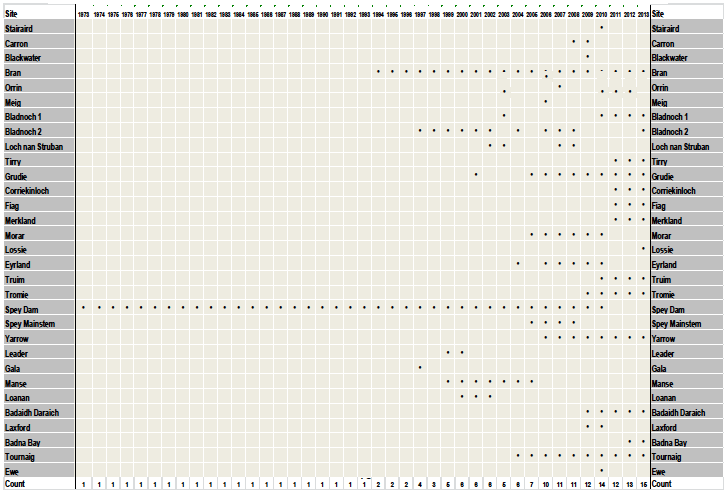
Table 11. Temporal distribution of individual fish length format data as provided for this project. In a limited number of cases further years exist in paper format but it was not possible to provide the data within the project timescales.
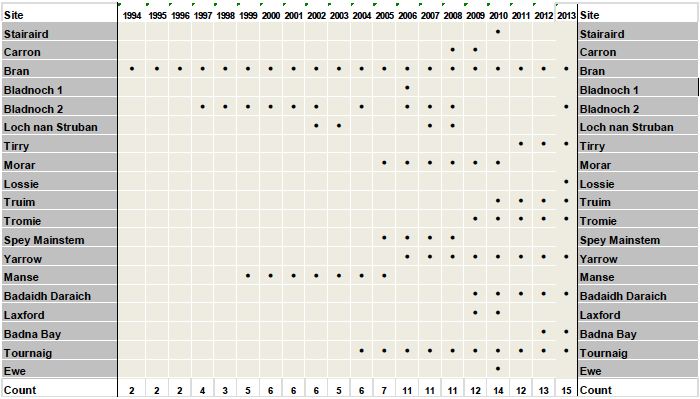
Contact
There is a problem
Thanks for your feedback
